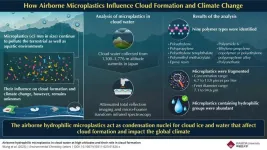(Press-News.org) A joint research team in China wrote a review on in-sensor visual computing, a three-in-one hardware solution that is more efficient, economical and secure than conventional machine vision systems, which collect, store, and interpret visual signals on separate hardware units. This review was published Sept. 26 in Intelligent Computing, a Science Partner Journal.
In-sensor visual computing systems are inspired by how humans and other mammals collect, extract and process visual signals, an intricate biological mechanism showing low latency and low energy cost. By integrating sensing, storage and computation onto the focal plane of image sensors, in-sensor visual computing systems process data within each sensor and extract only critical information from raw signals, rather than processing whole image data like conventional systems. Therefore, they have the potential to overcome the three major obstacles — high latency, high power consumption and privacy risks — that hinder the further development of their conventional counterparts.
The development of in-sensor computing devices has concentrated on novel circuit designs and new materials. The review centers on a vision chip with a novel circuit design called the SCAMP pixel processor array or SCAMP chip, which is relatively mature among emerging sensors and “an interdisciplinary and fertile research platform” for relevant research. First developed two decades ago, ever-improving focal-plane sensor-processors like the SCAMP chip have been widely used in computing experiments, but not thoroughly surveyed.
The authors first introduce the most up-to-date system based on the SCAMP chip, SCAMP-5d. It is a general-purpose, programmable, immensely parallel system extensively used in robotics and computer vision. Software tools and platforms developed for the SCAMP chip are also introduced, including development frameworks for programming the chip, semi-simulated and fully-simulated platforms for simulating the chip's operations and kernel filter compilers for optimizing visual processing algorithms.
Next, the authors give an overview of in-sensor visual computing algorithms and applications based on the versatile SCAMP chip. They survey algorithms ranging from lower-level image processing techniques, such as image enhancement and feature extraction, to higher-level tasks such as classification, localization and segmentation using neural networks. The applications enabled by these algorithms are mainly state estimation and robot navigation.
Although the in-sensor visual computing systems using the SCAMP pixel processor array have brought about extensive technological advances, they still have limitations such as low resolution, scarce computing resources, noise and unsatisfactory algorithm design and deployment. Compensating for current limitations while exploring other non-conventional computing methods such as sensor fusion and edge computing, engineers and researchers of next-generation SCAMP vision systems are trying to turn such obstacles into opportunities.
The authors themselves are actively involved in the “co-development and co-optimization of circuit design, integration technologies and associated algorithms” for academic and commercial purposes. They believe that next-generation SCAMP vision systems will show better performance at lower power consumption.
The authors are Yanan Liu of Shanghai University, Rui Fan of Tongji University, Jianglong Guo of Harbin Institute of Technology, Hepeng Ni of Shandong Jianzhu University, and M. Usman Maqboo Bhutta of The Chinese University of Hong Kong.
END
Integration propels machine vision
In-sensor visual computing explained, plus key devices, algorithms and applications
2023-09-27
ELSE PRESS RELEASES FROM THIS DATE:
Blocking abnormal stem cell signal during aging lessens related bone loss
2023-09-27
A cellular signal essential to the development of the skeleton increases during aging to weaken bones, finds a new study in mice.
The study, led by researchers from NYU Grossman School of Medicine, found that blocking the signaling pathway, called Notch, in aging skeletal stem cells caused a “massive increase” in bone mass and restored lost bone-healing ability during aging.
The study results revolve around immature stem cells, which have the capacity to mature into more than one cell type. Bone is among the tissues that keep pools of stem cells on hand into adulthood, ready to mature into replacement cells that maintain healthy tissue and repair ...
Henry Ford Health first in Michigan to introduce advanced prostate diagnostic technology
2023-09-27
DETROIT (Sept. 27, 2023) – Henry Ford Health is the first health system in Michigan to offer ExactVu, a cutting-edge technology for diagnosing and evaluating prostate cancer. Enhancing the precision and speed of diagnosis, this new technology ensures patients receive timely and appropriate care, while also providing a more efficient and convenient experience than other diagnostic methods.
"Throughout the years, advancements in prostate cancer diagnostic and treatment modalities have made a tremendous difference for patients,” said Craig Rogers, M.D., Chair of the Department of Urology at Henry Ford Cancer. “This is ...
Resolving a seeming contradiction, study advances understanding of visual recognition memory
2023-09-27
Because figuring out what is new and what is familiar in what we see is such a critically important ability for prioritizing our attention, neuroscientists have spent decades trying to figure out how our brains are typically so good at it. Along the way they’ve made key observations that seem outright contradictory, but a new study shows that the mystifying measures are really two sides of the same coin, paving the way for a long-sought understanding of “visual recognition memory” (VRM).
VRM is the ability to quickly recognize the familiar things in scenes, which can then be de-prioritized so that we can focus on the new things that might be more important ...
The Buck Institute and Phenome Health announce major strategic partnership
2023-09-27
The Buck Institute for Research on Aging and Phenome Health are joining forces in the quest to understand the biology of aging. Phenome Health, a Seattle-based nonprofit research organization led by CEO Lee Hood, MD, PhD, uses a data-driven approach to health and disease that integrates diverse types of biological big data. The new Center for Phenomic Health at the Buck will be co-led by Dr. Hood, who joins the Buck as Chief Innovation Officer and Distinguished Professor, and Eric Verdin, MD, Buck President ...
Revolutionary breakthrough: human stomach micro-physiological system unveiled
2023-09-27
A groundbreaking development in biomedical engineering has led to the creation of a human stomach micro-physiological system (hsMPS), representing a significant leap forward in understanding and treating various gastrointestinal diseases, including stomach cancer. The research team, led by Professor Tae-Eun Park from the Department of Biomedical Engineering at UNIST and Professor Seong-Ho Kong from Seoul National University Hospital, has successfully developed a biomimetic chip that combines organoid and organ-on-a-chip technologies to simulate the complex defense mechanisms of the human gastric mucosa.
Organoids, which mimic human organs using stem cells, have ...
ORNL launches Center for AI Security Research to study AI’s impacts on society, security
2023-09-27
The Department of Energy’s Oak Ridge National Laboratory announced the establishment of its Center for AI Security Research, or CAISER, to address threats already present as governments and industries around the world adopt artificial intelligence and take advantage of the benefits it promises in data processing, operational efficiencies and decision-making.
In partnership with federal agencies such as the Air Force Research Laboratory’s Information Directorate and the Department of Homeland Security (DHS) Science and Technology Directorate ...
Extreme weight loss: Star sheds unexpected amounts of mass just before going supernova
2023-09-27
Cambridge, Mass. — A newly discovered nearby supernova whose star ejected up to a full solar mass of material in the year prior to its explosion is challenging the standard theory of stellar evolution. The new observations are giving astronomers insight into what happens in the final year prior to a star’s death and explosion.
SN 2023ixf is a new Type II supernova discovered in May 2023 by amateur astronomer Kōichi Itagaki of Yamagata, Japan shortly after its progenitor, or origin star, ...
Target: BP™ intitiative helps more than 8.6 million Americans with hypertension improve heart health
2023-09-27
DALLAS, September 27, 2023 — The American Heart Association and American Medical Association (AMA) nationally recognized 1,709 health care organizations (HCOs) — 400 more than in 2022 — for their efforts to prioritize control of their patients’ blood pressure (BP), a leading preventable risk factor for heart disease, stroke and premature death.
According to the 2022 American Heart Association Statistical Update, nearly half of U.S. adults — 121.5 million ...
Tiny CRISPR tool could help shred viruses
2023-09-27
HOUSTON – (Sept. 27, 2023) Small and precise: These are the ideal characteristics for CRISPR systems, the Nobel-prize winning technology used to edit nucleic acids like RNA and DNA.
Rice University scientists have described in detail the three-dimensional structure of one of the smallest known CRISPR-Cas13 systems used to shred or modify RNA and employed their findings to further engineer the tool to improve its precision. According to a study published in Nature Communications, the molecule works differently than other proteins in the same family.
“There are different types of CRISPR systems, and the one ...
Plastic cloud: New study analyzes airborne microplastics in clouds
2023-09-27
Plastic particles less than 5 mm in size are called “microplastics.” These tiny bits of plastic are often found in industrial effluents, or form from the degradation of bulkier plastic waste. Research shows that large amounts of microplastics are ingested or inhaled by humans and animals alike and have been detected in multiple organs such as lung, heart, blood, placenta, and feces. Ten million tons of these plastic bits end up in the ocean, released with the ocean spray, and find their way into the atmosphere. This implies that microplastics may have become an essential component of clouds, ...
LAST 30 PRESS RELEASES:
House sparrows in northern Norway can help us save other endangered animals
Crohn's & Colitis Foundation survey reveals more than 1/3 of young adults with IBD face step therapy insurance barriers
Tethered UAV autonomous knotting on environmental structures for transport
Decentralized social media platforms unlock authentic consumer feedback
American Pediatric Society announces Vanderbilt University School of Medicine as host institution for APS Howland Visiting Professor Program
Scientists discover first method to safely back up quantum information
A role for orange pigments in birds and human redheads
Pathways to net-zero greenhouse gas emissions for Southeast Asia
A JBNU–KIMS collaborative study on a cost-effective alloy matches superalloys for power plants and energy infrastructure
New study overturns long-held model of how plants coordinate immune responses.
New AI model predicts disease risk while you sleep
Scientists discover molecular ‘reshuffle’ and crack an 80-year-old conundrum
How stressors during pregnancy impact the developing fetal brain
Electrons lag behind the nucleus
From fungi to brain cells: one scientist's winding path reveals how epigenomics shapes neural destiny
Schizophrenia and osteoporosis share 195 genetic loci, highlighting unexpected biological bridges between brain and bone
Schizophrenia-linked genetic variant renders key brain receptor completely unresponsive to both natural and therapeutic compounds
Innovative review reveals overlooked complexity in cellular energy sensor's dual roles in Alzheimer's disease
Autism research reframed: Why heterogeneity is the data, not the noise
Brazil's genetic treasure trove: supercentenarians reveal secrets of extreme human longevity
The (metabolic) cost of life
CFRI special issue call for papers: New Frontiers in Sustainable Finance
HKU Engineering scholar demonstrates the smallest all-printed infrared photodetectors to date
Precision empowerment for brain "eavesdropping": CAS team develops triple-electrode integrated functional electrode for simultaneous monitoring of neural signals and chemical transmitters during sleep
Single-capillary endothelial dysfunction resolved by optoacoustic mesoscopy
HKU three research projects named among ‘Top 10 Innovation & Technology News in Hong Kong 2025’ showcasing excellence in research and technology transfer
NLRSeek: A reannotation-based pipeline for mining missing NLR genes in sequenced genomes
A strand and whole genome duplication–aware collinear gene identification tool
Light storage in light cages: A revolutionary approach to on-chip quantum memories
Point spread function decoupling in computational fluorescence microscopy
[Press-News.org] Integration propels machine visionIn-sensor visual computing explained, plus key devices, algorithms and applications







